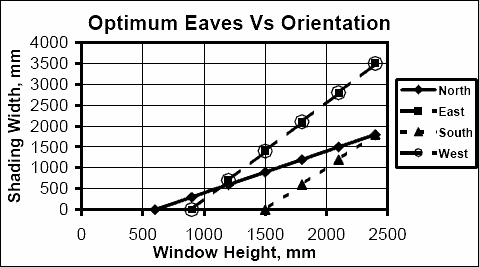Optimal Window Eaves Shading
- Clyde Anderson
- Jan, 15, 2011
- Efficient Design Elements, Energy Assessment Tools, Energy calculations
- Comments Off on Optimal Window Eaves Shading
Following from Window Design for House Efficiency the contribution of windows to the total building Energy Efficiency is considered. The BERS 3.2 thermal simulation was used to determine the optimum eaves width for glazing of different heights. The optimum was the minimum of Cooling Energy plus Heating Energy. This article refers only to the Brisbane climate.
A house design tested had high thermal mass, high insulation, low infiltration and single glazing on one side. For glazing facing each true cardinal direction (North, East, South and West), there was a certain shading eaves width that achieved a minimum of energy to maintain comfort for a range of window heights (see Figure). Average “eaves” width for a building elevation included shading structures like carport, patio, porch, verandah or pergola (allowance for percent shade). Eaves width was from the surface of the glass to the edge of the soffit. Window height was from the bottom sill to horizontal with the lower corner of the soffit (Offset = 0).
Optimum shading values for East and West were the same. Eaves smaller than the optimum gave a hotter house than the optimum shading width, and larger eaves gave a colder house.
To determine the optimum eaves width for other directions the following formula should be used:
Wo (θ) = Wo (α) + ( 1 + cos [2 × (φ – θ)] ) × { Wo (φ) – Wo (α) } ÷ 2
Where Wo (θ) = Optimum average eaves width of glazing facing the true angle θ
θ = The direction of the glazing in question
α = The cardinal direction with the smaller optimum eaves width
φ = The cardinal direction with the larger optimum eaves width
For example, consider a 1800mm high window facing 20° West of true South. From the Figure, the true West optimum eaves width is 2100mm and the true South optimum eaves width is 600mm. The formula is therefore:
Wo (θ) = 600 + ( 1 + cos [2 × (90° – 20°)] ) × {2100 – 600} ÷ 2 = 775mm, or say 800mm

